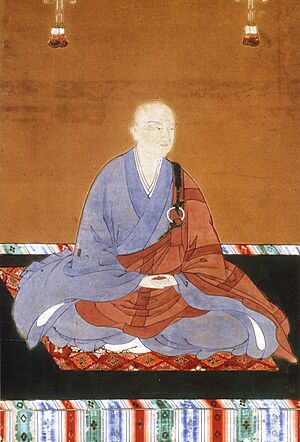Emperor Kōmyō facts for kids
Quick facts for kids Emperor Kōmyō光明天皇 |
|||||
|---|---|---|---|---|---|
 |
|||||
| 2nd Northern Emperor | |||||
| Reign | 20 September 1336 – 18 November 1348 | ||||
| Coronation | 19 January 1338 | ||||
| Predecessor | Kōgon | ||||
| Successor | Sukō | ||||
| Born | 11 January 1322 | ||||
| Died | 26 July 1380 (aged 58) | ||||
| Burial | Daikōmyō-ji no Misasagi (大光明寺) | ||||
|
|||||
| Father | Emperor Go-Fushimi | ||||
| Mother | Saionji (Fujiwara) Neishi | ||||
Emperor Kōmyō (光明天皇, Kōmyō Tennō) (born January 11, 1322 – died July 26, 1380) was an important figure in Japanese history. He was the second of the Northern Emperors. However, he was the first emperor to be fully supported by the powerful Ashikaga government. His time as emperor lasted from 1336 to 1348.
Contents
Who was Emperor Kōmyō?
Emperor Kōmyō's personal name was Yutahito. He was the second son of Emperor Go-Fushimi. His mother was a woman named Neishi. She was the daughter of a nobleman, Saionji Kinhira.
Kōmyō had a daughter named Jogakuin-dono. She lived until 1422. He also had another daughter and a son named Shuson.
Key Events in Kōmyō's Reign
Emperor Kōmyō and the people around him believed he was the rightful emperor. He sat on the Chrysanthemum Throne from September 20, 1336, to November 18, 1348.
How Kōmyō Became Emperor
In 1336, a powerful general named Ashikaga Takauji rebelled. He was fighting against Emperor Go-Daigo's government, known as the Kenmu Restoration. Takauji entered the capital city of Kyōto.
Emperor Go-Daigo had to flee to a temple called Enryaku-ji on Mount Hiei. Even though Prince Yutahito (Kōmyō) did not have the special sacred treasures that show an emperor's power, he was still made emperor. This event started the Northern Court.
Soon after, on December 21, Emperor Go-Daigo escaped to a place called Yoshino. There, he started his own government, which became known as the Southern Court. This began a long period of two rival imperial courts in Japan.
Kōmyō Steps Down as Emperor
On November 18, 1348, Emperor Kōmyō decided to give up his throne. He passed it on to his older brother's eldest son. This prince then became Emperor Sukō.
Being Captured by the Southern Court
In April 1352, a big family fight happened within the Ashikaga clan. This fight was called the Kan'ō Disturbance. The Southern Emperor, Emperor Go-Murakami, took advantage of this.
He entered Kyoto and captured it. He also took Emperor Kōmyō, along with Emperor Kōgon, Emperor Sukō, and the Crown Prince Tadahito. They were all taken to Anau, where the Southern Court was located.
Life After the Throne
During a time known as the Shōhei Reunification, Kōmyō and the other captured emperors were kept under house arrest. This happened in Yamato Province, in an area that is now Nishiyoshino Village.
In 1355, Emperor Kōmyō returned to Kyōto. He then decided to join a monastery, living a religious life.
He passed away on July 26, 1380, at the age of 60.
Era Names During Kōmyō's Rule
In Japan, years are often counted using special "era names" called nengō. During Emperor Kōmyō's time, there were two different sets of era names because of the Northern and Southern Courts.
Northern Court Eras
These are the era names used by the Northern Court, which Emperor Kōmyō led:
Southern Court Eras
These are the era names used by the Southern Court, which was the rival court:
Southern Court Rivals
Emperor Kōmyō faced two main rivals from the Southern Court:
See also
 In Spanish: Kōmyō Tennō para niños
In Spanish: Kōmyō Tennō para niños
- Emperor of Japan
- List of Emperors of Japan
- Imperial cult
- Emperor Go-Kōmyō
| Regnal titles | ||
|---|---|---|
| Preceded by Emperor Kōgon |
Northern Emperor 1336–1348 |
Succeeded by Emperor Sukō |

